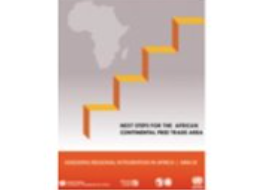Signed by 52 African countries, the African Continental Free Trade Area (AfCFTA) is, by the number of participating countries, the largest trade agreement since the formation of the WTO. By 1 April 2019, only one year and ten days after the signature, the threshold of ratification by 22 countries required for the agreement’s entry into force had been reached. The speed of this ratification is unprecedented in African Union history.
With so much achieved in so impressive an amount of time, it is time to think ahead to where the momentum of the AfCFTA can be taken. That is the inspiration for this ninth edition of the flagship Assessing Regional Integration in Africa report (ARIA IX), which asks: “What’s next for the AfCFTA?”
In answering, the report recognizes that it is not enough for the AfCFTA to be merely negotiated, concluded, and ratified. It must also change lives, reduce poverty and contribute to economic development. For this, the AfCFTA must be effectively operationalized but also supported with complementary measures that leverage it as a vehicle for economic development.
This framework facilitates the development of new policies and is scheduled to commence on intellectual property rights, investment and competition policy in late 2019. These policy areas are the core focus of this report, which takes stock of the current situation across the continent in each of these areas and identifies recommendations for substantive provisions in the AfCFTA. In looking ahead, the report also considers e-commerce and integration in a digitizing Africa, and how the digital economy can interact with the AfCFTA and trade in Africa.
 Welcome to the United Nations
Welcome to the United Nations
